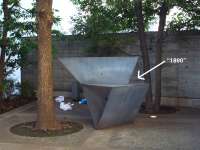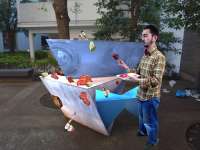Untitled project Nobuo Yoda
This project is a proposal for Daikanyama Installation 2009 that was rejected. Daikanyama Installation 2009 is a call for installations that is held every two years in Daikanyama area (Meguro Ward), a district in Tokyo popular for its medium-high level fashion shops and its trendy caffés and restaurants.
The project is untitled and it consists of an intervention on Kanjiro Okazaki’s “1890”, a sculpture made of iron, with some parts painted, located in a square at a corner of Daikanyama Hillside Terrace (a complex of apartments, shops and restaurants): the idea is to heat the sculpture up and then cook meat and vegetables on it, in order to make a little outdoor barbecue. The barbecue would take place on a sunny afternoon.
First, for hygienic reasons, the part of the sculpture made of iron will be thoroughly cleaned up and sterilized. Then, some oil is applied on the metallic surface, including the upward angled part, before heating it up with a gas burner. When the surface reaches the adequate temperature, food ingredients are put on it until they are cooked. The artist (myself) eats the food and anyone else can as well, if he/she wishes.
The central idea of the project is to make this sculpture, placed in a public space, pursue temporarily a “different life” by using it as a practical tool for cooking food. In this sense, the project does not intervene in the conceptual specificity of “1890”, in its solidness, linearity and lightness, but it attempts instead to put it in a position that is unrelated to these components; in other words, what is intervened is the status of “1890” as a final outcome.
The intervention, thus, forms a sort of collage, where the work of the original artist, my action on it, the participating elements and their variable nature (e.g., the sculpture, barbecue, viewers, me) and the inscription of the intervention itself in the history of “1890” are gathered and mixed, producing the possibility of a new, equivocal public monument.
Untitled project Nobuo Yoda
This project is a proposal for Daikanyama Installation 2009 that was rejected. Daikanyama Installation 2009 is a call for installations that is held every two years in Daikanyama area (Meguro Ward), a district in Tokyo popular for its medium-high level fashion shops and its trendy caffés and restaurants.
The project is untitled and it consists of an intervention on Kanjiro Okazaki’s “1890”, a sculpture made of iron, with some parts painted, located in a square at a corner of Daikanyama Hillside Terrace (a complex of apartments, shops and restaurants): the idea is to heat the sculpture up and then cook meat and vegetables on it, in order to make a little outdoor barbecue. The barbecue would take place on a sunny afternoon.
First, for hygienic reasons, the part of the sculpture made of iron will be thoroughly cleaned up and sterilized. Then, some oil is applied on the metallic surface, including the upward angled part, before heating it up with a gas burner. When the surface reaches the adequate temperature, food ingredients are put on it until they are cooked. The artist (myself) eats the food and anyone else can as well, if he/she wishes.
The central idea of the project is to make this sculpture, placed in a public space, pursue temporarily a “different life” by using it as a practical tool for cooking food. In this sense, the project does not intervene in the conceptual specificity of “1890”, in its solidness, linearity and lightness, but it attempts instead to put it in a position that is unrelated to these components; in other words, what is intervened is the status of “1890” as a final outcome.
The intervention, thus, forms a sort of collage, where the work of the original artist, my action on it, the participating elements and their variable nature (e.g., the sculpture, barbecue, viewers, me) and the inscription of the intervention itself in the history of “1890” are gathered and mixed, producing the possibility of a new, equivocal public monument.

